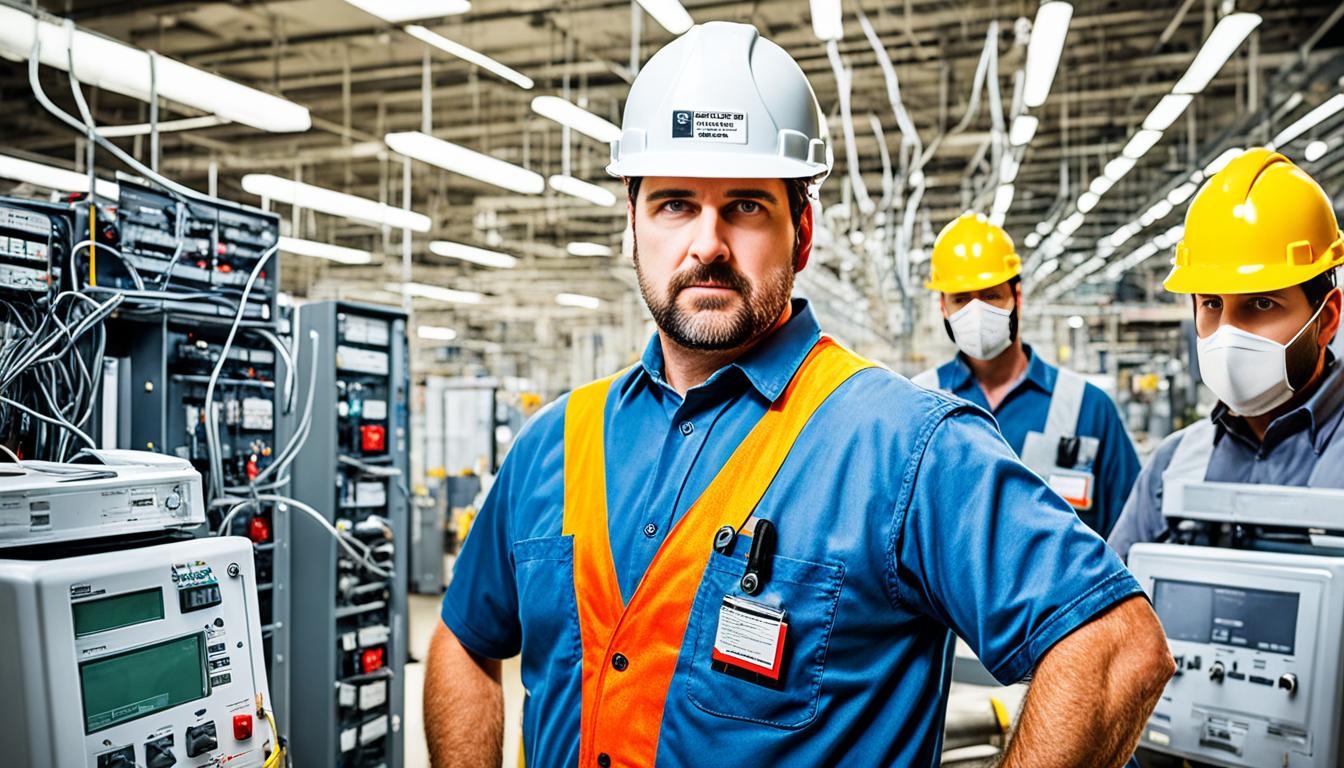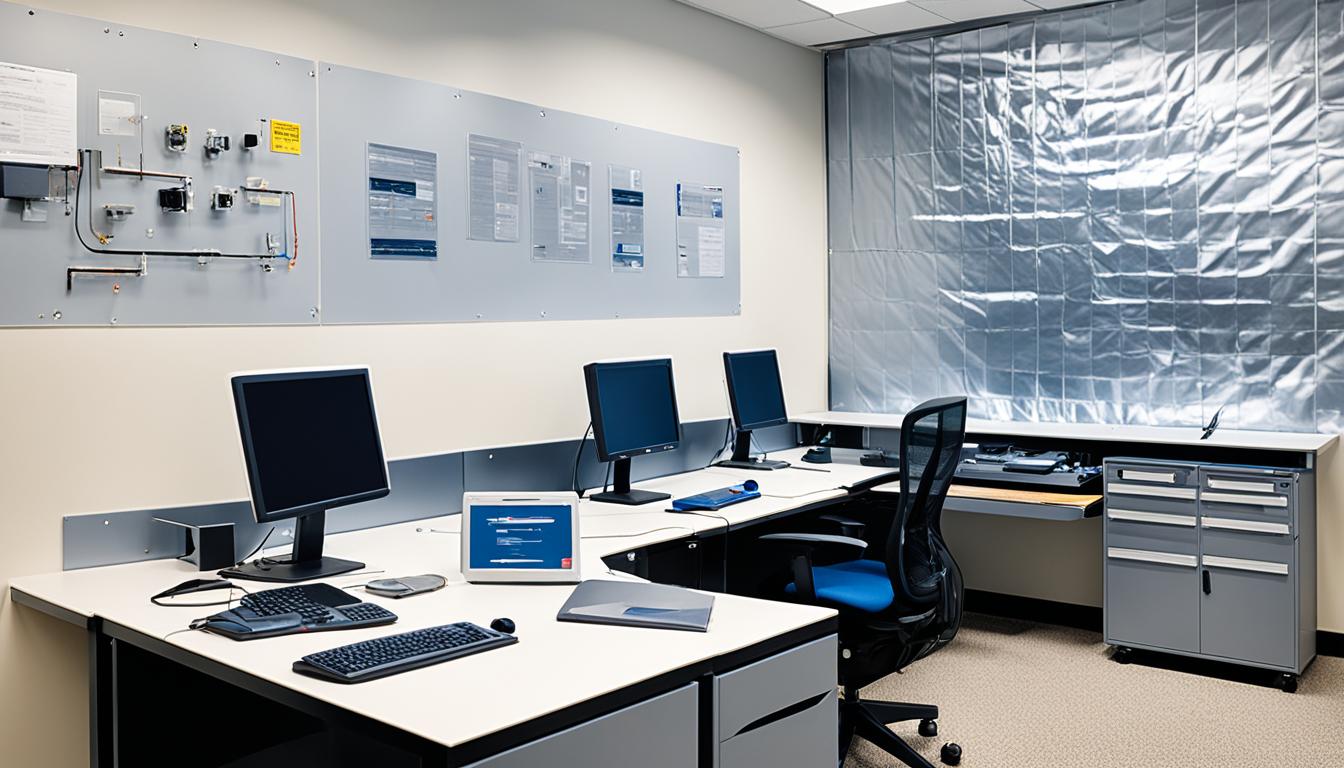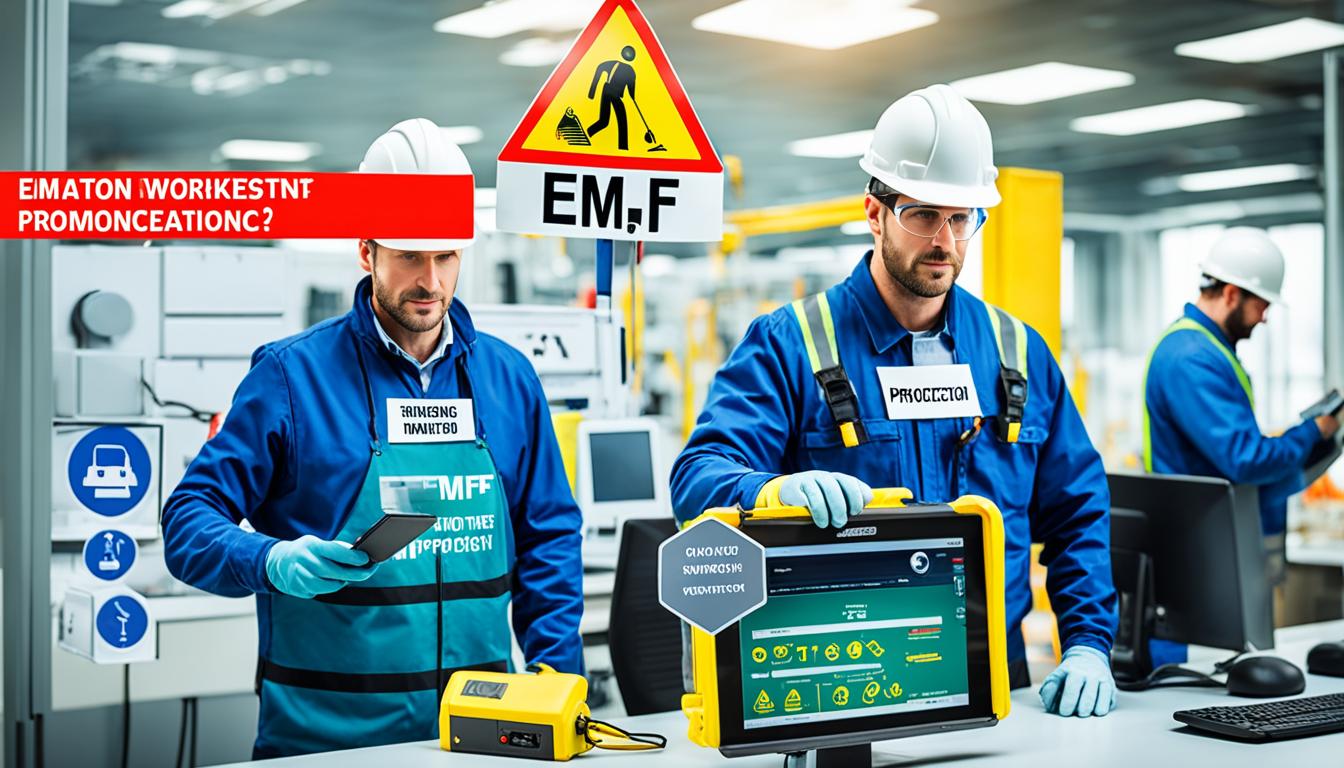Disclosure: This Post Contains Affiliate Links; We earn a commission on purchases.
Electromagnetic Fields (EMF) and Radio Frequencies (RF) are a common presence in the modern workplace. However, these fields can pose significant risks to the health and safety of workers. It is important for employers to understand and navigate workplace EMF risks to ensure the well-being of their employees.
The Control of Electromagnetic Fields at Work Regulations 2016 (CEMFAW) in the UK outline the management systems required for industries that use equipment producing EMFs and RFs. These regulations guide employers in identifying, assessing, and controlling the risks associated with EMF exposure in the workplace.
Employers have the responsibility to implement measures that limit EMF exposure, ensuring electromagnetic field safety. By following the guidelines provided by the Health and Safety Executive (HSE), employers can create a safer work environment and protect their employees from the potential health effects of EMFs.
Key Takeaways
- Workplace EMF risk navigation is crucial for ensuring employee health and safety.
- The Control of Electromagnetic Fields at Work Regulations 2016 (CEMFAW) provides guidance for managing EMF exposure in the workplace.
- Employers should assess, control, and reduce EMF exposure to prevent risks to their workers.
- The Health and Safety Executive (HSE) offers guidelines for identifying, assessing, and controlling EMF risks in the workplace.
- By prioritizing electromagnetic field safety, employers can create a healthier working environment for their employees.
Understanding EMFs in the Workplace
In today’s modern workplace, the use of electric and electronic equipment is commonplace. However, it’s essential to understand the potential risks associated with electromagnetic fields (EMFs) that are produced by such equipment. EMFs can have adverse effects on workers, leading to symptoms like nausea, vertigo, muscle contractions, and rises in core body temperature. To ensure the well-being of employees, it is crucial to assess and manage EMF risks in the workplace.
Workers with implanted or body-worn medical devices, as well as expectant mothers, are particularly vulnerable to the potential harmful effects of EMFs. That’s why conducting EMF risk assessments is vital. By identifying and evaluating the exposure levels of EMFs, employers can take appropriate measures to protect their workforce.
“The Health and Safety Executive (HSE) provides comprehensive workplace EMF guidelines to assist employers in controlling and mitigating risks associated with EMFs.”
To effectively manage EMF risks, it is important to refer to the workplace EMF guidelines provided by the HSE. These guidelines identify equipment that produces low-level EMFs and offer recommendations for controlling and mitigating the associated risks. This information empowers employers to implement suitable measures and safeguards in their workplaces.
Steps for Controlling and Mitigating EMF Risks in the Workplace
| Steps | Description |
|---|---|
| 1 | Identify equipment producing EMFs |
| 2 | Assess exposure levels |
| 3 | Implement control measures |
| 4 | Provide training to employees |
| 5 | Monitor and review EMF risks regularly |
“By following the workplace EMF guidelines, employers can create a safer working environment for their employees and minimize the potential health risks associated with EMFs.”
Understanding EMFs and their impact is crucial for employers and workers to ensure a safe and healthy workplace. By staying informed and implementing the recommended workplace EMF guidelines, employers can protect their employees from potential harm and foster a culture of safety.
EMF Regulations and Compliance
In order to ensure a safe working environment, the UK has implemented specific regulations known as The Control of Electromagnetic Fields at Work Regulations 2016 (CEMFAW). These regulations require employers to assess and limit employees’ exposure to EMFs in the workplace, thereby managing EMF risks effectively.
Compliance with the workplace EMF regulations involves several key steps. Employers must begin by identifying the sources of EMFs within their work environment. This may include equipment such as computers, printers, and machinery that produce electromagnetic fields.
Once the EMF sources have been identified, employers must assess the exposure levels to determine the potential risks to employees. This assessment will help employers understand the extent of the EMF hazards and devise appropriate control measures.
Establishing safe systems of work is crucial for managing EMF risks effectively. This may involve implementing engineering controls, such as shielding or enclosing EMF sources, and ensuring employees are properly trained on how to operate equipment safely.
Providing comprehensive training to employees is an essential part of compliance with workplace EMF regulations. Through training programs, employees can learn about the potential health effects associated with EMF exposure and understand how to protect themselves. It is particularly important to consider the specific risks associated with workers who use body-worn medical devices or are pregnant.
“Compliance with workplace EMF regulations involves identifying EMF sources, assessing exposure levels, establishing safe systems of work, and providing training to employees.”
Ongoing supervision, audit training, and health surveillance are integral aspects of managing EMF risks in the workplace. Regularly monitoring the work environment, conducting audits, and providing health checks or medical examinations can help identify any emerging risks and ensure employee well-being.
To provide a comprehensive understanding of workplace EMF regulations and compliance, refer to the table below for a clear breakdown of the key requirements:
| Workplace EMF Regulations & Compliance Requirements |
|---|
| Identify EMF sources |
| Assess exposure levels |
| Establish safe systems of work |
| Provide training to employees |
| Consider specific risks for users of body-worn medical devices and pregnant workers |
| Ensure ongoing supervision, audit training, and health surveillance |
By adhering to these workplace EMF regulations and actively managing EMF risks, employers can create a safe and healthy working environment for their employees.

Protecting Employees from EMFs
Protecting employees from the harmful effects of electromagnetic fields (EMFs) should be a top priority for employers. By implementing effective EMF protection measures, employers can ensure the safety and well-being of their workers. Here are some key steps to consider:
Appoint a Competent Person
First and foremost, it is important to appoint a competent person responsible for identifying and assessing EMF risks in the workplace. This person should have the necessary knowledge and expertise to evaluate the potential hazards associated with EMF exposure and implement appropriate control measures.
Implement Suitable Management Controls
To protect employees from EMFs, it is essential to implement suitable management controls and systems of work. This may include modifying work processes, implementing engineering controls, or providing personal protective equipment (PPE) where necessary. By taking proactive measures, employers can minimize EMF exposure and reduce the associated risks.
Provide Training and Information
Ensuring that employees are well-informed and trained on EMF protection is crucial. Employers should provide comprehensive training programs that cover the risks associated with EMFs, how to identify potential hazards, and the appropriate control measures to mitigate those risks. Regular information updates should also be provided to keep employees aware of any changes or updates in EMF protection protocols.
Monitor and Control Visits to EMF Sources
For employers with a mobile workforce or workers visiting sites with EMF sources, it is important to monitor and control these visits. This may involve site assessments to identify potential EMF risks, implementing control measures specific to the site, and regularly reviewing and updating protocols to ensure ongoing protection for workers.
Collaborate with Landlords, Occupiers, and Clients
Collaboration with landlords, occupiers, and clients is essential in creating a safe work environment for employees. By working together, employers can ensure that EMF protection measures are in place throughout various work locations and comply with relevant regulations. Regular communication and collaboration are key to maintaining a safe working environment for all.
By taking proactive steps to protect employees from EMFs, employers can create a workplace that prioritizes worker safety and minimizes the risks associated with EMF exposure.
Examples of Effective EMF Protection Measures
| EMF Protection Measures | Description |
|---|---|
| Engineering controls | Modifying equipment or work processes to reduce EMF exposure. |
| Personal protective equipment (PPE) | Providing employees with protective gear, such as EMF shielding garments or shields for electronic devices. |
| Workplace reorganization | Reconfiguring work areas or equipment layout to minimize EMF exposure. |
| Regular EMF risk assessments | Conducting regular assessments to identify potential EMF hazards and update control measures as needed. |
| Employee training and awareness programs | Providing comprehensive training on EMF risks, hazards, and best practices for minimizing exposure. |
| Collaboration with external stakeholders | Working closely with landlords, occupiers, and clients to implement consistent EMF protection measures. |
Identifying and Managing Specific Risks
When conducting a workplace EMF risk assessment, it is crucial to identify employees who may have a higher vulnerability to harm. This includes individuals with body-worn medical devices, passive or active implantable medical devices, or metal implants. These employees may be at increased risk of experiencing adverse effects from electromagnetic fields (EMFs).
Specific risk assessment and control measures may be necessary for workers in high EMF environments, such as those involved in outside broadcasts or working near high-powered electrical equipment. It is important to consider the potential impact of EMFs on these employees and implement suitable controls to minimize their exposure.
Gathering information about workers’ health and any changes that may affect their susceptibility to EMFs is vital for managing the risks effectively. Regular health check-ups and open channels of communication can provide valuable insights into individual risk profiles and help make appropriate adjustments to their work environment.
Examples of Specific Risks:
- Employees with body-worn medical devices, such as pacemakers or insulin pumps:
- These individuals may need additional precautions to ensure the safe operation of their medical devices in the presence of EMFs.
- Employees with passive or active implantable medical devices:
- These workers may require specific risk assessments and controls to reduce any potential interference with their implantable devices.
- Employees with metal implants:
- Workers with metal implants, such as joint replacements or metal plates, may have an increased risk of localized heating in the presence of EMFs. It is essential to monitor their exposure levels and implement appropriate protective measures.
By proactively identifying and managing these specific risks, employers can ensure the safety and well-being of their employees in environments where EMFs are present.

| Risk Factor | Considerations |
|---|---|
| Employees with body-worn medical devices | Additional precautions and risk assessments may be necessary to ensure the safe operation of medical devices. |
| Employees with passive or active implantable medical devices | Specific measures should be taken to minimize any potential interference with the functioning of implantable devices. |
| Employees with metal implants | Localized heating risks should be monitored and suitable protective measures implemented for workers with metal implants. |
Training and Awareness Programs
Training programs based on industry guidelines play a crucial role in equipping employers, managers, and workers with the necessary knowledge to understand and manage the hazards and risks of electromagnetic fields (EMFs) in the workplace. These programs not only educate individuals about workplace EMF guidelines but also emphasize the importance of EMF protection for workers.
There are several reputable organizations and resources that offer comprehensive training programs, ensuring a well-informed workforce capable of implementing effective EMF protection measures. Two prominent examples are the Masts & Towers Safety Group and Ofcom, both known for their expertise in EMF management and workplace safety.
The training programs provided by these organizations cover various aspects of EMF safety, ranging from face-to-face training sessions to online eLearning options. Continuous emphasis on the importance of EMF protection through refresher training helps reinforce the knowledge and best practices gained during initial training.
One of the key objectives of these programs is to raise awareness about workplace EMF guidelines and empower individuals to mitigate risks. By learning how to identify potential EMF sources, assess exposure levels, and implement appropriate control measures, workers can actively contribute to creating a safer working environment.
Additionally, these programs highlight the significance of collaboration between employers, managers, and workers in ensuring effective EMF protection. By fostering a culture of awareness and understanding, organizations can establish a collective commitment to workplace EMF prevention, ultimately safeguarding the well-being of employees.
“Proper training and awareness are vital components of EMF protection in the workplace. By equipping individuals with the necessary knowledge and skills, we empower them to manage EMF risks effectively and safeguard the health and safety of workers.”
By prioritizing training and awareness programs, employers demonstrate their commitment to workplace EMF prevention and employee well-being. With a well-informed workforce, organizations can effectively implement workplace EMF guidelines and ensure comprehensive EMF protection for workers.
| Benefits of Training and Awareness Programs: |
|---|
| • Increased awareness of workplace EMF guidelines |
| • Enhanced knowledge of EMF hazards and risks |
| • Improved ability to identify and assess EMF sources |
| • Acquired skills to implement effective control measures |
| • Fostered collaboration and collective commitment to EMF protection |
Reducing EMF Exposure in Home Offices
While we often focus on EMF exposure in traditional workplaces, it’s essential to recognize that home offices can also be sources of electromagnetic field (EMF) exposure. Gadgets, appliances, and even home wiring contribute to EMF pollution, which can lead to various health problems over time. To create a safer work-from-home environment, it’s crucial to take steps to reduce EMF exposure in home offices.
Here are some recommendations to reduce EMF exposure in home offices:
- Hardwire internet connections: Instead of relying solely on a Wi-Fi connection, consider using an Ethernet cable to hardwire your internet connection. This reduces your exposure to Wi-Fi signals emitted by routers.
- Unplug devices when not in use: Many devices continue to emit low levels of EMFs even when not actively in use. By unplugging devices such as printers, monitors, and chargers when not in use, you can minimize unnecessary exposure.
- Replace LED and CFL light bulbs with incandescent ones: LED and CFL light bulbs can emit elevated levels of EMFs. Consider using incandescent bulbs instead to reduce your exposure to these electromagnetic fields.
- Use corded phones: While wireless phones are convenient, they emit radio frequencies that can contribute to EMF exposure. Opt for corded phones instead to minimize your exposure.
- Limit the use of wireless computer accessories: Wireless keyboards, mice, and other computer accessories emit EMFs. Whenever possible, choose wired alternatives to reduce your exposure.
By implementing these recommendations, you can effectively reduce EMF exposure within your home office, creating a healthier and safer environment for work.
Conclusion
Managing workplace EMF risks is a crucial responsibility for employers. By carefully assessing, controlling, and reducing EMF exposure, employers can create a safer and healthier working environment for their employees.
Compliance with relevant regulations, such as The Control of Electromagnetic Fields at Work Regulations 2016 (CEMFAW), is essential. These regulations provide guidelines and requirements for identifying and managing EMF risks in the workplace, ensuring that employees are protected.
In addition, implementing proper training and awareness programs is vital. By equipping employees, managers, and employers with the knowledge and skills to understand and manage EMF risks, it becomes easier to navigate the complexities of the modern workplace.
Furthermore, identifying and managing specific risks, such as those associated with workers using body-worn medical devices or pregnant employees, is crucial. Taking the necessary steps to address these specific risks ensures that all employees are protected from potential harm.
Lastly, reducing EMF exposure in home offices is also important. By adopting simple measures such as hardwiring internet connections and using corded phones, employees can minimize their EMF exposure and create a safer work-from-home environment.
By prioritizing employee safety, staying informed about EMF risks, and implementing these strategies, employers can successfully navigate workplace EMF risks, manage EMF risks effectively, and prevent EMF-related health issues. This proactive approach fosters a safer and healthier workplace for all.
Source Links
- https://www.shponline.co.uk/occupational-health/dangers-of-electromagnetic-fields-and-radio-frequencies-at-work/
- https://www.intertek.com/blog/2019/02-28-emf/
- https://workinmind.org/2021/12/15/concerned-about-emf-pollution-in-your-home-office-heres-what-you-can-do/

Subscribe to Our Newsletter








